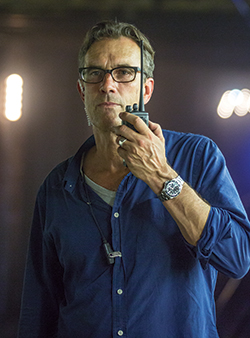Fall 2014
 Analyzing 1st AD David Webb’s impressive résumé—studded with political dramas such as Argo (2012), Promised Land (2012), The Ides of March (2011), and Milk (2008)—his choices make perfect sense when seen in the context of what he says was his original career path.
Analyzing 1st AD David Webb’s impressive résumé—studded with political dramas such as Argo (2012), Promised Land (2012), The Ides of March (2011), and Milk (2008)—his choices make perfect sense when seen in the context of what he says was his original career path.
“I went to college for political science and journalism,” Webb says during a break on Martin Scorsese’s new rock ‘n’ roll series for HBO.“I always planned on being a war correspondent.”
Battle plans were redefined—but only marginally so—when Webb took on logistically complicated projects like Sean Penn’s Into the Wild (2007), which shot for 10 straight months and had more than 40 different production offices.
“Sean’s commitment is total—all in, 100 percent,” says Webb. “And that made for the greatest adventure you can have [in filmmaking]. If the scene called for some lost corner of Lake Mead, or the most remote backcountry in Alaska, that’s where it had to take place. No exceptions.”
One such example entailed bringing a Technocrane deep into Denali National Park in Alaska. “There’s only one road in and out, so when monsoon season hit, all of the bridges washed out,” Webb recalls. “The Techno guys had to get back to LA for Spider-Man, but it took us days until the engineers got us out.”
Webb’s current series with Scorsese, about the travails of a music executive in the late ’70s, is one of his most inspiring, craft-wise. “[DP] Rodrigo Prieto and I sat with Marty for a week before we started, annotating and storyboarding every single scene,” he explains. “We know exactly what each shot will be every single day, and yet within that very careful structure the actors have enormous freedom.”
One episode required re-staging Led Zeppelin’s infamous 1973 concert at Madison Square Garden, and another re-created the last show performed at Manhattan’s Mercer Arts Center, when the roof caved in on the New York Dolls. “In the old days we would have had to do everything in camera,” says Webb. “But thanks to VFX, now we only do the human interactions.”
Interiors were shot at a church in Brooklyn, and the exteriors in Lower Manhattan on Crosby and Houston streets. “So we’re on the streets of SoHo for many nights, with period cars, lights, and backgrounds, and then [producer] Mick Jagger comes to the set, which adds another level of [media] attention to everything.”
Ben Affleck was another director who insisted on period authenticity. For Argo, “we started casting the CIA roles in February, because Ben wanted the hairstyles to grow out [and match the late-’70s style] to shoot in August. We went to Istanbul in May to cast all of the revolutionaries for the big scene to be shot in October.”
But that was just the preparation for shooting the siege of the American embassy in Istanbul. “We had thousands of extras to portray this city on the edge of anarchy,” says Webb, clearly relishing the challenge.
“We locked down many blocks of downtown Istanbul, and had these massive traffic jams. It was incredible to re-create this moment in history that was so iconic and yet so chaotic at the same time.”